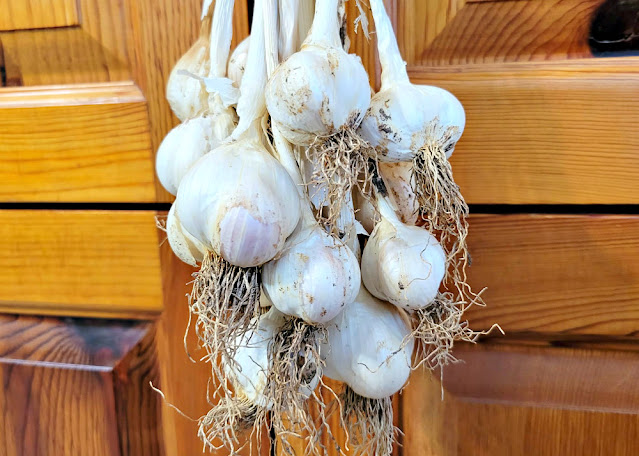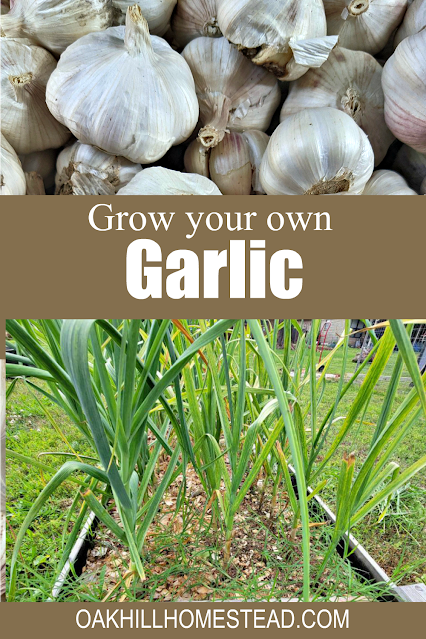Garlic is a great plant for beginning gardeners to grow. Learn how to grow garlic in pots, containers or raised beds, the difference between hardneck and softneck garlic, why the best time to plant garlic is in the fall, and how to care for garlic over the winter.
How to plant garlic from cloves
Are you interested in growing garlic in your garden? Or maybe you’re looking for something you can plant now, even though it’s the very end of the gardening season in most of North America.
Even if you’re not planning to grow a fall garden, this is the time to plant garlic. Let’s talk about why you should consider growing garlic in the fall and how to get started.
Want to listen instead? Here you go!
Garlic is a well-known member of the onion family, with a pungent flavor and aroma. I think everyone knows how garlic smells, right?
Garlic grows as a set of cloves, enclosed in a layer or two of papery skin. These cloves grow together in a bulb, which also has a papery skin around it.
This post may contain affiliate links, which means if you click on a link and make a purchase I might earn a small commission, but it doesn't affect the price you pay. Read my disclosure here for more info.
The best time to plant garlic
Unlike other garden plants, the best time to plant garlic is in the fall instead of in spring.
If you have decided you want to start a garden, but it’s already the end of summer… well, you don’t have to wait until spring. Garlic should be planted in the fall, which makes it a perfect get-started plant.
What I love about planting garlic in the fall is that there isn’t much going on in my garden at the time.
There aren’t a hundred other tasks to be done, and I can grow something over the winter, when very little else grows without a greenhouse or other protection from winter's harsh weather.
Garlic is an easy crop to plant and to grow, making it perfect for winter growing in my opinion. And it’s super easy to grow too!
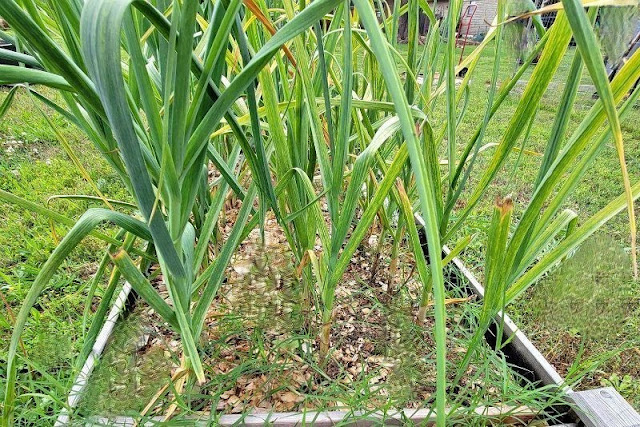 |
| Fall-planted garlic in the following summer. Garlic cloves are planted 4-6 inches apart, and at least 2 inches from the edge of the bed or container. |
Why garlic planting season is in the fall
Garlic needs a cold treatment to encourage the plant to form that iconic garlic bulb. We plant individual cloves, and when garlic is ready to harvest, we will hopefully have an entire bulb of garlic, formed of several cloves.
This period of cold treatment helps the plant to form that garlic bulb.
You could put your garlic in the refrigerator before planting, or you can plant it in the fall and let nature provide the perfect cold treatment.
Planting in the fall also provides a longer growing season so you’ll get larger, flavorful garlic bulbs.
Garlic continues to grow during the winter, first forming a good root system underground. By the time spring's warmer weather arrives, your garlic plant is ready to send up shoots and start growing up towards the sun.
Can you plant garlic in the spring? Yes - scroll down this post to read about it!
The benefits of growing garlic
There are so many reasons to grow your own garlic.
Garlic adds flavor and aroma to many recipes. While chopped raw garlic is very pungent and sharp, when garlic is cooked it has a sweet and almost buttery flavor that is amazing.
Don't believe me? Make some roasted garlic. You'll have plenty of homegrown garlic to make this recipe!
While it's famous as an ingredient in Italian and other Mediterranian foods, garlic is also used in Asia, Europe, Africa and Latin America, and of course in North American recipes as well.
Garlic is low in calories and contains several vitamins such as vitamin C, E and K, and minerals such as calcium and iron, although the amounts are relatively small. [Source]
Garlic also has an abundance of medicinal or health uses. Garlic has been used for centuries to treat various ailments and to prevent others.
For example, eating raw garlic is a popular way to boost one's immune system, and to lower blood pressure and cholesterol.
Garlic has antibiotic, antiseptic and antifungal properties, and has been used to treat internal parasites. Garlic might even reduce the risk of dementia. [Source]
As well as being easy to grow, garlic is easy to store after you’ve harvested it, and it’s so versatile to use in cooking that growing it in your garden is a simple decision, even if you're a beginning gardener.
What to plant with garlic
Garlic is also a natural pest deterrent. Used as a companion plant with other vegetables, it's supposed to help repel aphids, cutworms and other pests.
Because you’ll need to plant those other vegetables in the spring, it’s a good idea to plan this out when you plant your garlic.
Garlic gets along with nearly everything in the garden, but you don’t want to plant it with peas, beans, melon, and asparagus.
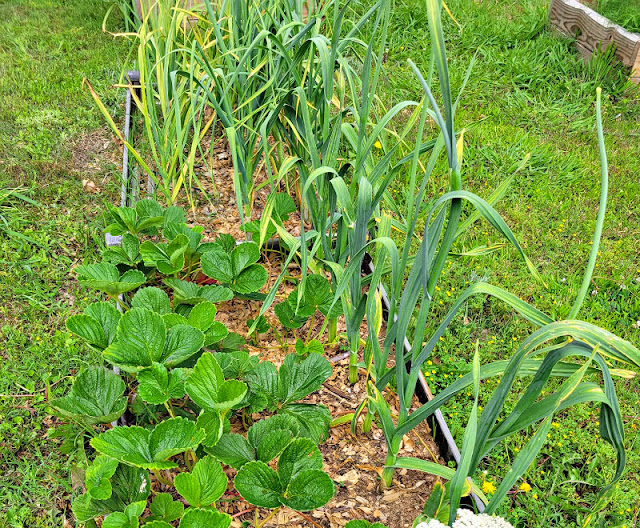 |
| Garlic planted with strawberries. Garlic is a good companion for almost all garden plants. |
You also shouldn’t plant garlic near its close relatives: onions and leeks, which might attract onion maggots.
Also know that garlic will be ready to harvest around June or July, depending on where you live. It lives longer than just over the winter, so plan your space accordingly.
Garlic doesn't take up a lot of space though, so you can sow companion plants in between the garlic if you plan well.
Where to plant garlic
Garlic likes the sun, so plant it in a full-sun location. It also loves fertile and well-drained soil.
You can grow garlic in large pots, in planters and in raised beds, so you don't need a large garden to plant a few garlic cloves. (If you're using pots, you'll find the spacing requirements for garlic further down in this post.)
Each clove of garlic will grow into a bulb of garlic with 5-7 cloves, depending on your weather and other growing conditions.
Because garlic really likes well-draining soil, some gardeners add a bit of sand to their soil before planting garlic.
The difference hardneck and softneck garlic, and which one you should plant
There are two types of garlic: hardneck and softneck.
The difference between softneck and hardneck garlic is the "neck," the stem that grows up the center of the garlic bulb, surrounded by the cloves.
Hardneck varieties have a central stalk that grows up through the garlic. Softneck garlic has a smaller, softer “neck” that forms the leaves of the plant.
Hardneck varieties tend to have a deeper flavor profile and character, while softneck varieties have milder flavor. This makes them a good choice for culinary uses.
Most grocery stores sell softneck garlic because it has a longer shelf life.
Softneck garlic is easier to braid into decorative ropes because they don’t have that stiff stalk. Braids are an easy way to store garlic in the kitchen, where it is easy to snip a bulb off the rope for use.
Hardneck garlic is more cold-hardy and can withstand harsh winter temperatures, while softneck garlic prefers hot summers and mild winters.
 |
| Hardneck garlic |
There are many varieties of hardneck and softneck garlic, and your choices are nearly endless.
You should also consider the following to determine which garlic varieties will do well in your area:
- Your climate and growing conditions
- How you will use the garlic (culinary and/or medicinal)
- Your flavor preferences
- The garlic variety’s storage needs
- Disease resistance - if you're buying your seed garlic online, you'll usually find this information in the description.
What about elephant garlic?
You may have heard of elephant garlic and wonder which category it falls in.
Actually, elephant garlic is more closely related to leeks (another member of the allium family) than to garlic, even though it forms a bulb and tastes similar to garlic.
Planting elephant garlic is done in the same manner as planting hardneck or softneck garlic cloves.
Elephant garlic cloves are also planted in the fall, just like regular garlic. It is usually harvested after about eight months, during the following summer.
Technically though, elephant garlic is a biennial, and needs two years to reach full maturity, unlike garlic which forms a bulb after just one growing season.
The first year you might harvest just one large clove of elephant garlic instead of a bulb with several cloves, although if the growing season is long enough it can produce a bulb.
You can leave an elephant garlic plant in the ground for an additional year; it should divide into individual cloves by the second summer.
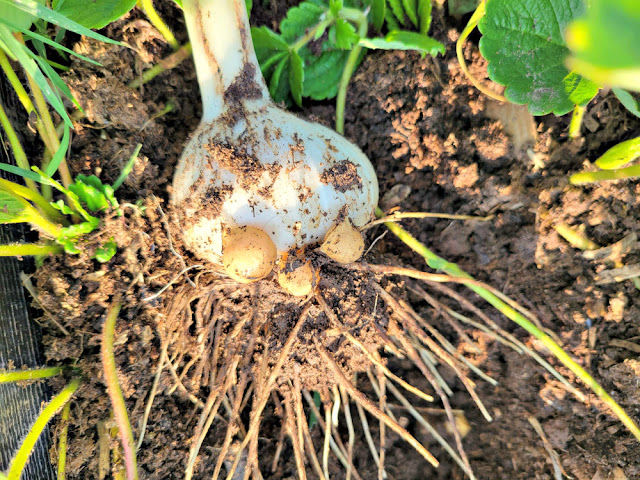 |
| A large single clove of elephant garlic with corms attached. Corms are basically "elephant garlic seeds" and can be replanted. |
Elephant garlic sometimes has "corms" attached to the bulb, which are basically elephant garlic seeds. You can plant the corms and let them grow another season. You'll probably harvest one large clove at the end of the season.
Then you can replant that one large clove and get a bulb or head of garlic with several cloves in it the following season.
Can you grow garlic from store bought cloves?
Yes, you can. Growing garlic from store bought garlic bulbs is the same as using seed garlic. (Seed garlic simply means garlic that is sold to be planted. You can buy seed garlic online.)
Here are a few things to consider though:
Store-bought garlic is often shipped from China, and is often treated to prevent sprouting. A better choice would be to buy organic garlic from the farmers market or a grocery store that carries organic options.
Store bought garlic is usually a softneck variety, which is not cold-hardy. If you live in a cold climate, it might not grow successfully. A hardneck variety would be a better choice for you.
But you can certainly experiment and give it a try, especially if you have a sprouted clove in your kitchen pantry!
When to plant garlic
We've already mentioned that the best time to plant garlic is in the fall. But exactly when in the fall should garlic be planted?
Garlic needs to be planted at least two weeks before the first frost of the season. Don’t wait until the ground is frozen; not only will it be too hard to work the soil, the cold soil will not allow the garlic to begin growing.
September and October are good months to plant garlic if you live in a cold-weather region. In warmer areas you can plant garlic as late as November or even December if the ground hasn't frozen yet.
Garlic grows its root system below ground over the winter, and when the milder weather of spring arrives, the plants send up their stalks and leaves and begin growing above-ground.
Can you plant garlic in the spring?
Yes, you can. BUT...
Remember that garlic needs a cold period in order to form a good bulb. This cold treatment is called vernalization.
Also, garlic requires about nine months to mature into full-size bulbs.
However, you can plant garlic in the spring and use the immature bulbs like you'd use scallions. The entire plant is edible (but you'll enjoy the tender leaves more than the tougher, old leaves!).
You can give your garlic cloves a cold treatment before planting by placing them in the refrigerator for 4-6 weeks.
And plant as early in the spring as possible. If you have a warm spell in late winter, that might be a good time to plant your garlic cloves.
Should you soak garlic before planting?
Some gardeners soak their garlic cloves before planting, others do not. You can decide whether or not you wish to do so.
This is a two-step soaking method I've used in the past.
For the first soak, combine one gallon of warm water, a tablespoon of organic fish fertilizer, and one tablespoon of baking soda in a bucket.
Add your garlic cloves to this mix and let them soak for at least 15 minutes, but no more than 12 hours. Drain the cloves.
This mixture is supposed to give your cloves a shot of fertilizer to get them off to a great start.
Then the cloves are given a second soak in either rubbing alcohol, hydrogen peroxide or cheap vodka. This will kill any mites and sterilize the cloves, reducing the chances of fungus or bacterial issues.
Soak for 20 minutes, then drain the garlic cloves and plant. Cloves should be planted within one hour of soaking for best results.
How to plant and grow garlic from cloves
Prepare your soil before you get ready to plant by adding some well-rotted manure or good compost. Garlic likes well-draining soil that is loose and fertile.
Compost and manure add fertility and also loosen dense soil. If your soil is extremely dense, such as clay soil, you might want to add some sand or vermiculite as well.
Add a bit of bone meal to each planting hole to help your plants produce large bulbs.
Separate your garlic bulbs into cloves, leaving the papery covering on. Planting the largest cloves will give you bigger bulbs at harvest time - you can eat the smaller cloves!
Plant the garlic cloves individually in the prepared soil, with the pointed end up.
It's important to make sure the garlic clove is right side up in the ground. Other garden plants and seedlings are pretty good at figuring out which end should be up, even if you plant them upside down, but garlic isn’t one of them.
The blunt, larger end is the bottom, and the pointy end is the top.
Plant each clove about 1-2 inches deep in that soft soil you’ve prepared, and space the cloves 4-6 inches apart.
If you’re planting garlic in pots, plant the cloves 2” from the edge of the pot, and allow at least 4 inches between cloves.
Cover the cloves up and gently pat the soil down a bit.
When you've planted all of your cloves, cover the bed or container with several inches of mulch. Use a generous layer, 3" to 6" deep. Mulch is what keeps your garlic from freezing over the winter.
Finally, water very well.
If you have snow cover in the winter, this might be the last time you have to water until spring. The mulch will help hold moisture in the soil, providing the perfect growing environment for your garlic.
Keep an eye on your garlic bed throughout the fall and winter. Water about once a week if needed. Your garlic will go dormant over the cold winter months and you won’t need to water as long as you have regular rain or snow.
The best mulch for garlic
Mulching your garlic bed is an important step. The mulch protects your garlic from harsh weather, from the cold, and also keeps down weeds when spring arrives.
But not all mulch is created equal.
Straw is widely-used and an excellent material. There’s a difference between straw and hay though. Hay has seeds in it, and will give you a crop of weeds.
Wheat straw is more likely to have seeds in it, so if you can find oat or barley straw, they are a better choice.
If you see seed heads in your straw when you mulch the garlic, remove as many of them as you can or you’ll be sorry later. Trust me in this.
Fallen leaves are another excellent mulch material, and they are free for the work of raking them up in the fall.
If possible, spread the leaves out on your lawn and run over them with the lawnmower to chop them up, then rake up to use as mulch.
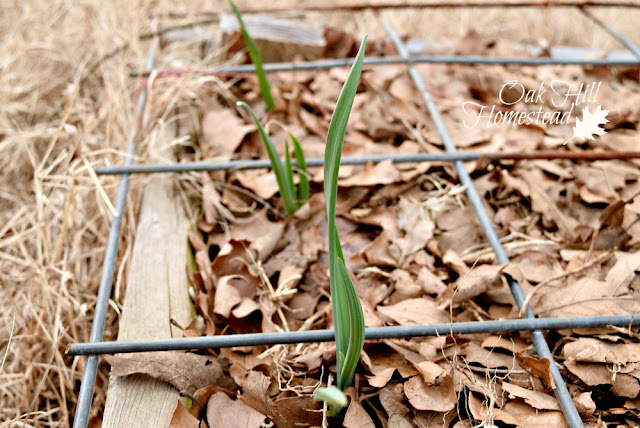 |
| Wire fencing on top of the mulch will help keep the mulch from blowing away in windy areas. In spring, the garlic leaves grow up through the mulch. |
Dried-out grass clippings from summer lawn mowing is also a good mulching material.
I’ve also used pine shavings from the feed store, sold as “stall bedding” for horses.
Whatever you use as mulch, it should have some “fluff” to it, not be packed down so densely that water can’t penetrate. Your garlic plants will have to grow up through the mulch in the spring, so you don't want your mulch materials to be too dense or compacted.
If you live in a very windy location like I do, you can set some wire fencing over the top of the mulch to help keep it from blowing away. I have to do this, or I’ll have bare ground before spring arrives.
I’ve used wire fencing with various sized holes - whatever I have on hand - as well as sheets of plastic lattice. Whatever you use must allow moisture to penetrate and water the garlic below.
Your garlic shoots will grow up through the mulch and whatever you've put on top of it, unless you remove the fencing or other material in the spring.
Where to buy seed garlic
Seed garlic (garlic that is sold to be planted instead of eaten) is available from online retailers such as Mary's Heirloom Seeds, Baker Creek Seeds, and others.
Why not grow garlic in pots or in your backyard garden this year. Growing your own garlic is fun as well as delicious, and it so easy to grow. Garlic stores well, and is absolutely delicious and healthy too.
For more gardening posts like this, subscribe to my weekly newsletter The Acorn, and join me on Facebook, Instagram and Pinterest. I'd love to see you there!
Related posts:
My mission is to inspire and encourage you to live a simple, joyful life,
no matter your circumstances or where you live. Join me here:
Facebook | Pinterest | Instagram | Subscribe

